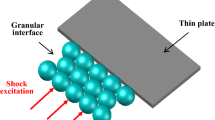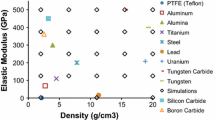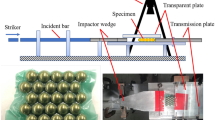Abstract
Due to the nonlinear nature of the inter-particle contact, granular chains made of elastic spheres are known to transmit solitary waves under impulse loading. However, the localized contact between spherical granules leads to stress concentration, resulting in plastic behavior even for small forces. In this work, we investigate the effects of plasticity in wave propagation in elasto-plastic granular systems. In the first part of this work, a force–displacement law between contacting elastic-perfectly plastic spheres is developed using a nonlinear finite element analysis. In the second part, this force–displacement law is used to simulate wave propagation in one-dimensional granular chains. In elasto-plastic chains, energy dissipation leads to the formation and merging of wave trains, which have characteristics very different from those of elastic chains. Scaling laws for peak force at each contact point along the chain, velocity of the leading wave, local contact and total dissipation are developed.
















Similar content being viewed by others
References
Nesterenko, V.F.: Dynamics of Heterogeneous Materials. Springer, New York (2001)
Sen, S., Hong, J., Bang, J., Avalos, E., Doney, R.: Solitary waves in the granular chain. Physics Reports 462(2), 21 (2008)
Awasthi, A.P., Smith, K.J., Geubelle, P.H., Lambros, J.: Propagation of solitary waves in 2D granular media: a numerical study. Mech. Mater. 54, 100 (2012)
Manjunath, M., Awasthi, A., Geubelle, P.H.: Wave propagation in 2D random granular media. Phys. D Nonlinear Phenom. (2013, in press)
Johnson, K.: Contact Mechanics. Cambridge University Press, Cambridge (1985)
Thornton, C.: Coefficient of restitution for collinear collisions of elastic-perfectly plastic spheres. J. Appl. Mech. 64(2), 383 (1997)
Wang, E., Geubelle, P.H., Lambros, J.: An experimental study of the dynamic elasto-plastic contact behavior of metallic granules. J. Appl. Mech. 80(2) 021009 (2013)
Abbot, E.J., Firestone, F.A.: Specifying surface quality: a method based on accurate measurement and comparison. Mech. Eng. 55, 569 (1933)
Zhao, Y., Maletta, D.M., Chang, L.: An asperity microcontact model incorporating the transition from elastic deformation to fully plastic flow. J. Tribol. 122(1), 86 (2000)
Vu-Quoc, L., Zhang, X.: An elasto-plastic contact force displacement model in the normal direction: displacement-driven version. Proc. Roy. Soc. Lond. A 455(1991), 4013 (1999)
Kogut, L., Etsion, I.: Elastic-plastic contact analysis of a sphere and a rigid flat. J. Appl. Mech. 69(5), 657 (2002)
Jackson, R.L., Green, I.: A finite element study of elasto-plastic hemispherical contact against a rigid flat. J. Tribol. 127(2), 343 (2005)
Nesterenko, V.: Propagation of nonlinear compression pulses in granular media. J. Appl. Mech. Tech. Phys. 24(5), 733 (1983)
Vergara, L.: Model for dissipative highly nonlinear waves in dry granular systems. Phys. Rev. Lett. 104(11), 118001 (2010)
Rosas, A., Romero, A.H., Nesterenko, V., Lindenberg, K.: Observation of two-wave structure in strongly nonlinear dissipative granular chains. Phys. Rev. Lett. 98(16), 164301 (2007)
Rosas, A., Romero, A.H., Nesterenko, V., Lindenberg, K.: Short pulse dynamics in strongly nonlinear dissipative granular chains. Phys. Rev. E 78(5), 051303 (2008)
Carretero-Gonzalez, R., Khatri, D., Porter, M.A., Kevrekidis, P.G., Daraio, C.: Dissipative solitary waves in granular crystals. Phys. Rev. Lett. 102(2), 024102 (2009)
Khatri, D., Ngo, D., Daraio, C.: Highly nonlinear solitary waves in chains of cylindrical particles. Granul. Matter 14(1), 63 (2012)
Nguyen, N.S., Brogliato, B.: Shock dynamics in granular chains: numerical simulations and comparison with experimental tests. Granul. Matter 14(3), 341 (2012)
Manciu, M., Sen, S., Hurd, A.J.: Impulse propagation in dissipative and disordered chains with power-law repulsive potentials. Phys. D Nonlinear Phenom. 157(3), 226 (2001)
Manjunath, M., Awasthi, A.P., Geubelle, P.H.: Wave propagation in random granular chains. Phys. Rev. E 85(3), 031308 (2012)
Acknowledgments
The authors gratefully acknowledge the support by the Army Research Office through the Multi University Research Initiative Project Number W911NF0910436 (Dr. David Stepp, program director).
Author information
Authors and Affiliations
Corresponding author
Appendix: Energy dissipation
Appendix: Energy dissipation
The energy dissipation at a contact is given by the expression (31), where \(\alpha = \alpha _{max}\) is the maximum relative displacement attained at the contact. The total energy dissipated in the system upto location \(x_N\), as described by Eqs. (28–30) is given by (32), where \(\tilde{x} = x/R^*\) and \(E_t = d_0\left( \tilde{x}_t - \tilde{x}_1\right) + d_1 a\tilde{I} b \left( e^{-b\tilde{x}_1} - e^{-b\tilde{x}_t} \right) + 2 d_2 \left( a\tilde{I}\right) ^2 b \left( e^{-2 b \tilde{x}_1} - e^{-2 b \tilde{x}_t}\right) \) is the energy dissipated by the contact points in the first regime.
where the constants \(c_i\) are as defined in Sect. 2 and \(\varGamma (.,.)\) is the Gamma function. The total energy dissipation is
Rights and permissions
About this article
Cite this article
Pal, R.K., Awasthi, A.P. & Geubelle, P.H. Wave propagation in elasto-plastic granular systems. Granular Matter 15, 747–758 (2013). https://doi.org/10.1007/s10035-013-0449-1
Received:
Published:
Issue Date:
DOI: https://doi.org/10.1007/s10035-013-0449-1




